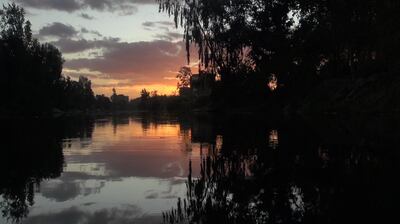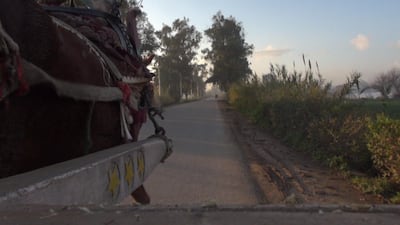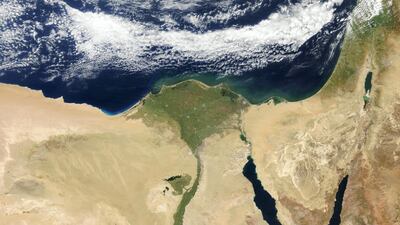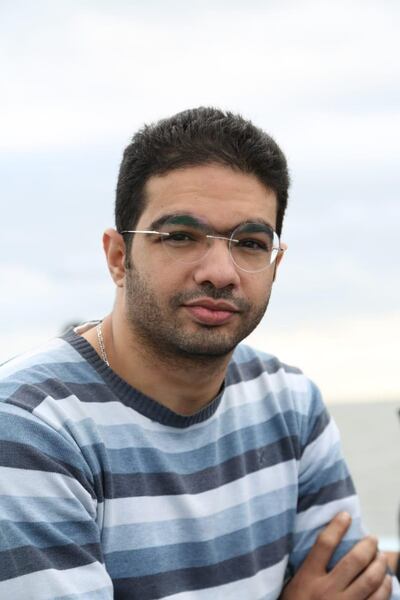When Sharief Zohairy set off to explore and film his travels around the Nile Delta in 2012, he had no idea it would take him almost a decade before the five-and-a-half-hour-long Seven Years Around the Nile Delta would fully take shape.
This month, the film had its festival debut at the 71st Berlin International Film Festival, and was screened as part of the event's Forum Expanded, which usually features more experimental works.
The film takes the audience on a journey to the various cities, towns and villages on the Nile Delta's triangle, in the same way Zohairy did over the years. He often travelled with nothing but a camcorder or his smartphone in hand, yet the film flows smoothly. Any unstable shots or faint, unclear sounds only serve to amplify the film's premise as a "cheap travelogue", as its subheading puts it, made with rudimentary equipment despite its sublimity.

El Zarqa village in Damietta, a town on the north-eastern Delta and Zohairy's birthplace, is where the film begins and ends. Shots taken from unconventional angles take centre, focusing on the periphery or what's often overlooked, immersing viewers in contemplative scenes that are more about the ambience of a place than a particular storyline. The shot is often less than perfect, dialogue isn't always directly related to the visuals and wide angles of factory sites or forlorn architecture evoke a sense of the traveller's transience.
Perhaps unsurprisingly, Seven Years Around the Nile Delta was the longest film to screen at the Berlinale this year, yet it does more to highlight the soundscapes, atmosphere and landscapes than it does bring forth a clear, specific idea. Zohairy's sound choices, for example, amplify the fluidity of time and place across the Delta. In one instance, a snippet of a 1962 Rushdy Abaza film plays over a three-minute-long shot of a slow sunset over the Nile's waters, as if heard from a distant coffee shop. At another point, a duo's argument on a felucca boat blurs into the background as a fisherman's silhouette takes centre.
The director's use of varied creative techniques, too, immerses viewers in the Delta's ambience, from its zars (rituals to drive away spirits) and moulids (festivals in remembrance of holy men and women), to weddings, circus events and even the more mundane surroundings, be it vast orchards or uneventful point-of-view shots from a donkey cart. The viewer is invited to experience the Nile Delta as a traveller would, whether by train, boat or van.

Zohairy says he was strongly influenced by Europe's post-First World War city symphonies genre, even if his own seven-year labour of love is more of a "rural, rather than urban, symphony", as he puts it. A genre that had its heyday in the silent filmmaking era up to the 1920s, and that has been revived more recently, city symphonies are typically documentaries that have no characters, plot nor narrative, a form Zohairy follows in presenting a day-in-the-life structure.
He says this particular period of filmmaking “brought this appreciation for documenting past and present through urban landscapes following a time of war, where some of these cities [featured in city symphonies at the time] were being rebuilt or undergoing architectural change”.
There were parallels with post-2011 Egypt, Zohairy explains, especially in the need to document the countryside as the most populous Arab country continues its obsession with property and building development.
“There was this disruption, this ongoing debate in the film industry following [Egypt’s 2011] revolution, about the subject matter films should tackle,” Zohairy says, explaining his motive to start working on the film in 2012.
"This also coincided with a widening availability of filming equipment as the digital revolution penetrated the film industry … All of these developments inspired me to go out and begin shooting Seven Years Around the Nile Delta, regardless of what I would come up with."
Filming and editing also led to Zohairy's unconventional creative choices. "My aims for the film changed over the years as I matured. I decided I wanted to focus less on the story, and instead showcase the sharp vicissitudes of travel," he explains. "When we're on a trip, we might forget something at home, or rely on a particular train showing up even if we don't know the schedule … similarly, there were many factors of unpredictability during our time working on the film, particularly since we were working at a minimal production level."
Despite the rudimentary film quality and lack of colour correction, the almost-cinema verite style enhances Zohairy's message through its contemplative approach. As the dividing line between feature and documentary filmmaking narrows, his aim of revealing the intricacies of life on the Delta through unconventional techniques, from experimenting with distinct sound layers to choosing not to stabilise shots, becomes all the more effective. This film becomes a brilliant depiction of everyday life in an often less-travelled region.
“I have always loved travelling, going on journeys to new places,” Zohairy says. And so his curiosity isn’t that of someone carrying an outsider’s limited lens, but rather that of a person sharing his own joys of travel.


